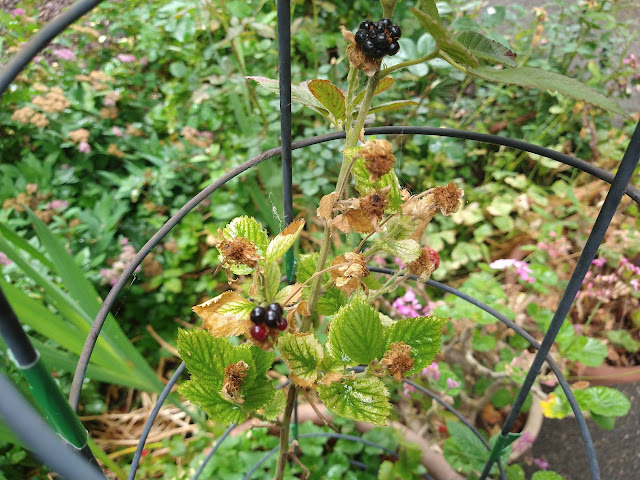
Poor blackberry pollination can be traced to spring weather

|
|
This Babycakes blackberry, a patio-size plant, produced just a few misshapen
berries this spring. Weather played a large part in the problem. (Photo: Debbie
Arrington)
|
This berry season, the bees let me down. My usually dependable blackberry plants bore precious few berries. The ones that did develop turned out misshapen. Instead of clusters of berries, the canes were covered with dried-up brown stubs.
I had lots of flowers – beautiful white blooms that usually attract bees with no problem. My blackberries grow near a big bed of roses; bringing pollinators into my backyard has never been a problem.
But this spring was different. In particular, my Babycakes dwarf blackberries fell victim to rollercoaster temperatures. Early April warmth (including 92 degrees on April 8) brought out the first berry blooms. But that was followed by a sudden plunge back into the 50s and frost on April 12. That sudden, unseasonable frost may have snuffed out pollinated blooms.
Once the flowers open, their stamens and pollen stay viable for only a short period (usually three days); they need bees when they need them. Honeybees don’t like wildly fluctuating temperatures. They don’t come out when it’s too cold or too hot, and it was both while those berries needed their help.
So the little pollination that did happen was extremely spotty; my guess, it was self-fertilization, not bees.
Adding to the berry dilemma were heat and drought, especially in June as berries were ripening.
Sacramento set a record for most 100-plus days in June; 11 days hit triple digits including a streak of eight straight. Three June days reached 104. That put heat stress on plants as berries were developing.
Vines already were thirsty. The last six months have been almost bone-dry, and even those notoriously vigorous blackberry roots were subject to dieback. Unless plants got supplemental irrigation, the vines tended to brown and often aborted berry production. (My Babycakes plant has the added challenge of growing in a large pot.)
And it’s not just my poor Babycakes that’s suffering. I’ve seen a similar lack of pollination and vine dieback in blackberries in our local greenbelt.
Fortunately, my vines are already sprouting healthy green growth. It’s time to cut out the old canes with their brown stubble, and move on. Maybe I can get a fall harvest? We’ll see what the bees are doing in August.
For more on blackberries and other caneberries, here are UC cultivation notes: https://www2.ipm.ucanr.edu/agriculture/caneberries/Growth-and-Development/ Also, here's good information from the Sacramento County master gardeners on growing caneberries in our region: https://ucanr.edu/sites/sacmg/files/74193.pdf
Comments
0 comments have been posted.Sacramento Digs Gardening to your inbox.
Sites We Like
Garden Checklist for week of May 5
Survey your garden after the May 4 rainstorm. Heavy rain and gusty winds can break the neck of large flowers such as roses. Also:
* Keep an eye on new transplants or seedlings; they could take a pounding from the rain.
* Watch out for powdery mildew. Warmth following moist conditions can cause this fungal disease to “bloom,” too. If you see a leaf that looks like it’s dusted with powdered sugar, snip it off.
* After the storm, start setting out tomato transplants, but wait on the peppers and eggplants (they want warmer nights). Pinch off any flowers on new transplants to make them concentrate on establishing roots instead of setting premature fruit.
* Trim dead flowers but not leaves from spring-flowering bulbs such as daffodils and tulips. Those leaves gather energy to create next year's flowers. Also, give the bulbs a fertilizer boost after bloom.
* Pinch chrysanthemums back to 12 inches for fall flowers. Cut old stems to the ground.
* Mulch around plants to conserve moisture and control weeds.
* From seed, plant beans, beets, cantaloupes, carrots, corn, cucumbers, melons, pumpkins, radishes and squash.
* Plant onion sets.
* In the flower garden, plant seeds for asters, cosmos, celosia, marigolds, salvia, sunflowers and zinnias. Transplant petunias, zinnias, geraniums and other summer bloomers.
* Plant perennials and dahlia tubers for summer bloom.
* Don’t wait; plant summer bulbs, such as gladiolus and tuberous begonias.
* Harvest cabbage, lettuce, peas and green onions.